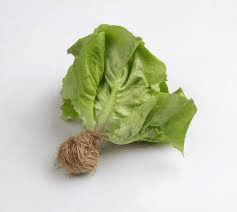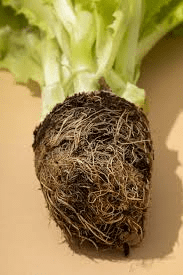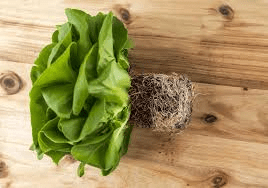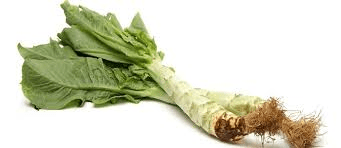Lettuce roots are an essential part of the lettuce plant (Lactuca sativa), playing a crucial role in its overall health and growth. These roots anchor the plant to the soil, absorb water and nutrients, and support the plant’s development throughout its lifecycle.
The root system of lettuce typically consists of a primary taproot and a network of secondary lateral roots. The taproot is the central root that grows downward into the soil, providing stability and access to deeper water and nutrients. From this central root, lateral roots branch out horizontally, creating a dense network that helps the plant efficiently absorb moisture and essential nutrients from a broader soil area.
Lettuce roots are generally shallow compared to those of many other plants, which is an adaptation to its relatively short growth cycle. This shallow root system allows the plant to quickly access nutrients in the upper layers of the soil, which is particularly advantageous in the early stages of growth. However, this also means that lettuce is more sensitive to soil conditions and requires consistent moisture to thrive.
The health of lettuce roots is critical for the overall vigor of the plant. Healthy roots ensure that the plant receives adequate water and nutrients, which are vital for producing crisp and flavorful leaves. Problems with the root system, such as poor drainage, compacted soil, or root diseases, can lead to stunted growth, reduced leaf quality, and lower yields.
Lettuce roots also play a role in the plant’s response to environmental conditions. For example, in dry conditions, the roots will grow deeper in search of water, while in waterlogged soils, they might struggle to get enough oxygen. Therefore, proper soil management is essential for maintaining an optimal root environment. Ensuring good drainage, avoiding soil compaction, and providing adequate irrigation can help support a healthy root system.
In addition to their role in nutrient and water absorption, lettuce roots are also involved in interactions with soil microorganisms. These interactions can benefit the plant by enhancing nutrient uptake and protecting against certain soil-borne diseases. For instance, mycorrhizal fungi can form symbiotic relationships with lettuce roots, aiding in the absorption of phosphorus and other essential nutrients.
The lettuce root system is fundamental to the plant’s growth and development. Its structure and function influence the plant’s ability to absorb water and nutrients, respond to environmental conditions, and ultimately produce high-quality lettuce. Understanding and managing the health of lettuce roots is essential for successful cultivation and achieving optimal yields.
The Economic Importance and Uses of Lettuce Roots

1. Culinary Uses: Lettuce roots are occasionally used in cooking, especially in Asian cuisine, for their mild, slightly earthy flavor and crunchy texture.
2. Nutritional Value: Lettuce roots contain dietary fiber and trace minerals, contributing to a balanced diet and supporting digestive health.
3. Composting: Lettuce roots can be composted to create nutrient-rich compost, enhancing soil health and fertility.
4. Organic Farming: Lettuce roots are utilized in organic farming practices as part of sustainable agriculture, reducing waste and promoting soil health.
5. Animal Feed: In some cases, lettuce roots can be used as feed for livestock, providing additional nutrients to animal diets.
6. Educational Demonstrations: Lettuce roots are used in educational settings to teach about plant growth, root systems, and sustainable agriculture.
7. Food Waste Reduction: Utilizing lettuce roots helps reduce food waste by making use of all parts of the plant that are often discarded.
8. Nutrient-Rich Fertilizers: Compost made from lettuce roots can be used as a natural fertilizer, improving soil quality for gardening and agriculture.
9. Soil Erosion Control: Lettuce roots can help prevent soil erosion by stabilizing the soil and reducing runoff in garden beds.
10. Sustainable Agriculture: Incorporating lettuce roots into farming practices supports sustainability by promoting efficient resource use and reducing waste.
11. Livestock Nutrition: Lettuce roots can be used in feed mixtures for livestock, contributing to balanced diets and healthy animals.
12. Herbal Remedies: Lettuce roots have been explored in traditional herbal remedies for their potential benefits, though they are less commonly used compared to other parts of the plant.
13. Biofuel Production: Lettuce roots are studied for their potential use in biofuel production, contributing to renewable energy sources.
14. Natural Dyes: Lettuce roots can be explored for use in natural dyes, providing eco-friendly color options for textiles and crafts.
15. Soil Amendments: Lettuce roots can be processed into soil amendments that enhance garden soil and support plant growth.
16. Research and Development: Lettuce roots are studied in agricultural research to explore their properties and potential applications in various industries.
17. Farmer’s Markets: Lettuce roots can be sold at farmer’s markets as part of the produce, offering additional value to consumers.
18. Livelihoods: Utilizing and selling lettuce roots creates income opportunities for farmers and contributes to local economies.
Read Also: How to Farm and Care for North Pacific Hake Fish (Merluccius productus)
The Products and By-products That Can Be Derived From Lettuce Roots

1. Culinary Ingredients: Lettuce roots are used in cooking, particularly in certain cuisines, to add a mild, slightly earthy flavor and crunchy texture.
2. Compost: Lettuce roots are composted to produce nutrient-rich compost that improves soil health and fertility.
3. Organic Fertilizers: Compost made from lettuce roots serves as a natural fertilizer for enhancing soil quality in gardening and agriculture.
4. Animal Feed: Lettuce roots can be used as feed for livestock, providing additional nutrients to animal diets.
5. Soil Erosion Control: Lettuce roots help stabilize soil and reduce erosion, contributing to soil conservation in garden beds.
6. Natural Dyes: Lettuce roots can be explored for use in natural dyes for textiles and crafts, offering eco-friendly color options.
7. Biofuel: Lettuce roots are researched for potential use in biofuel production, contributing to renewable energy sources.
8. Herbal Remedies: Lettuce roots are used in some traditional herbal remedies for their potential health benefits.
9. Soil Amendments: Processed lettuce roots can be used as soil amendments to improve garden soil quality.
10. Educational Kits: Lettuce roots are included in educational kits to teach about plant biology, root systems, and sustainable practices.
11. Sustainable Practices: Incorporating lettuce roots into various products supports sustainable practices by reducing waste and promoting efficient resource use.
12. Livestock Nutrition: Lettuce roots are used in feed mixtures to enhance livestock nutrition and contribute to animal health.
13. Research and Development: Lettuce roots are studied for their potential applications in agriculture, food processing, and other industries.
14. Farmer’s Markets: Lettuce roots are sold at farmer’s markets as part of fresh produce offerings, adding value to the market.
15. Waste Management: Utilizing lettuce roots helps manage waste by making use of parts of the plant that might otherwise be discarded.
16. Eco-Friendly Practices: Lettuce roots are used in eco-friendly practices, including composting and natural dyes, supporting sustainability.
17. Livelihood Opportunities: Selling lettuce roots and related products provides additional income opportunities for farmers and supports local economies.
Read Also: How to Farm and Care for Atlantic Horse Mackerel Fish (Trachurus trachurus)
Frequently Asked Questions (FAQ’s) About Lettuce Roots

1. How are lettuce roots used in cooking?
Lettuce roots are used in various culinary applications, particularly in some Asian cuisines. They add a mild, slightly earthy flavor and a crunchy texture to dishes such as soups and stir-fries. Their use in cooking is less common but valued in specific culinary traditions.
2. What nutritional benefits do lettuce roots offer?
Lettuce roots contain dietary fiber and trace minerals, which contribute to a balanced diet and support digestive health. They provide additional nutrients that can be beneficial when included in the diet.
3. How can lettuce roots be used in composting?
Lettuce roots are composted to create nutrient-rich compost. This compost improves soil health and fertility, making it a valuable addition to gardening and agriculture practices.
4. Can lettuce roots be used as animal feed?
Yes, lettuce roots can be used as feed for livestock. They provide additional nutrients that can enhance animal diets and contribute to overall livestock health.
5. How do lettuce roots contribute to sustainable agriculture?
Utilizing lettuce roots in various practices supports sustainable agriculture by reducing waste, promoting efficient resource use, and enhancing soil health through composting and organic farming methods.
6. What role do lettuce roots play in soil erosion control?
Lettuce roots help stabilize soil and reduce erosion by anchoring the soil in garden beds. This prevents soil loss and supports soil conservation efforts.
7. How are lettuce roots used in educational settings?
Lettuce roots are used in educational settings to teach about plant growth, root systems, and sustainable agriculture. They provide a hands-on example of plant anatomy and function.
8. Can lettuce roots be included in health supplements?
Lettuce roots have been explored in traditional herbal remedies for their potential benefits, though they are less commonly used in health supplements compared to other plant parts.
9. How do lettuce roots support eco-friendly practices?
Lettuce roots support eco-friendly practices through their use in composting, natural dyes, and waste management. They help reduce waste and promote sustainable approaches to agriculture and industry.
10. How do lettuce roots support local economies?
Utilizing and selling lettuce roots creates additional income opportunities for farmers and contributes to local economies. They are often sold at farmer’s markets and included in various products, adding value to agricultural businesses.
Read Also: Potato Farming Guide – 7 Tips to Grow Sacks Full of Potatoes






